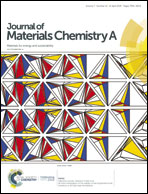Extremely low self-discharge solid-state supercapacitors via the confinement effect of ion transfer†
Abstract
Apart from low energy density, the rapid self-discharge phenomenon also severely limits the application of supercapacitors in periodic energy storage and power supply. Herein, we proposed a novel ‘playing mud pies’ strategy to prepare the high-performance bentonite clay@ionic liquid based solid-state electrolyte (BISE), which can efficiently solve the self-discharge issue of supercapacitors. The BISE-based supercapacitors display an extremely low self-discharge behavior with an open circuit potential drop of only 28.9% within 60 h, much better than that of conventional supercapacitors (40.1%@12 h). More importantly, even at a high temperature of 75 °C, the supercapacitors can still present a low voltage decline of 40% within 12 h and can stably deliver a high voltage of >1.5 V, which guarantees high-temperature energy conversion and storage application. We further proved that the low self-discharge mechanism originates from the confinement effect of silicon–oxygen bonds of the clay, which suppress the shuttle effect of Fe ions and promote selective penetration of electrolyte anions. Consequently, the remarkable decrease of both the ohmic leakage and diffusion-controlled faradaic process could sharply weaken the self-discharge behavior. Based on the BISE, we also developed soft-packaged supercapacitors with a low self-discharge value of 23.6%@20 h. Evidently, our ‘playing mud pies’ method can open a route to exploit extremely low self-discharge supercapacitors at widely ranging temperatures for deep insight into the self-discharge mechanism and further for efficient energy storage of supercapacitors.



 Please wait while we load your content...
Please wait while we load your content...